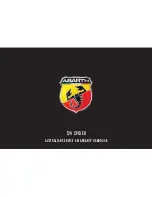
#
Make sure that the positive terminal of
the connected battery does not come
into contact with vehicle parts.
#
Never place metal objects or tools on a
battery.
#
When connecting and disconnecting the
battery, you must observe the descri‐
bed order for the battery clamps.
#
When giving starting assistance, always
make sure that you only connect bat‐
tery terminals with identical polarity.
#
During starting assistance, you must
observe the described order for con‐
necting and disconnecting the jumper
cables.
#
Do not connect or disconnect the bat‐
tery clamps while the engine is running.
&
WARNING Risk of explosion during
charging process and starting assistance
During the charging process and starting
assistance, the battery may release an explo‐
sive gas mixture.
#
Avoid fire, open flames, creating sparks
and smoking.
#
Make sure that there is sufficient venti‐
lation during the charging process and
during starting assistance.
#
Do not lean over a battery.
If the indicator/warning lamps in the instrument
cluster do not light up at low temperatures, it is
very likely that the discharged battery has fro‐
zen.
&
WARNING Risk of explosion from a fro‐
zen battery
A discharged battery may freeze at tempera‐
tures slightly above or below freezing point.
During starting assistance or battery charg‐
ing, battery gas may be released.
#
Always thaw a frozen battery out first
before charging it or performing start‐
ing assistance.
The service life of a battery that has been
thawed may be dramatically shortened.
It is recommended that you have a thawed bat‐
tery checked at a qualified specialist workshop.
All vehicles
*
NOTE Damage caused by numerous or
extended attempts to start the engine
Numerous or extended attempts to start the
engine may damage the catalytic converter
due to non-combusted fuel.
#
Avoid numerous and extended attempts
to start the engine.
Observe the following points during starting
assistance and when charging the battery:
R
Only use undamaged jumper cables/charg‐
ing cables with a sufficient cross-section and
insulated terminal clamps.
R
Non-insulated parts of the terminal clamps
must not come into contact with other metal
parts while the jumper cable/charging cable
is connected to the battery/jump-start con‐
nection point.
Breakdown assistance 331
Summary of Contents for E-Class Coupe
Page 6: ...Index 448 4 Contents ...
Page 7: ......
Page 8: ...6 At a glance Cockpit ...
Page 10: ...Instrument Display standard 8 At a glance Warning and indicator lamps ...
Page 12: ...Instrument Display in the Widescreen Cockpit 10 At a glance Warning and indicator lamps ...
Page 14: ...12 At a glance Overhead control panel ...
Page 16: ...14 At a glance Door control panel and seat adjustment ...
Page 18: ...16 At a glance Emergencies and breakdowns ...
Page 486: ......
















































